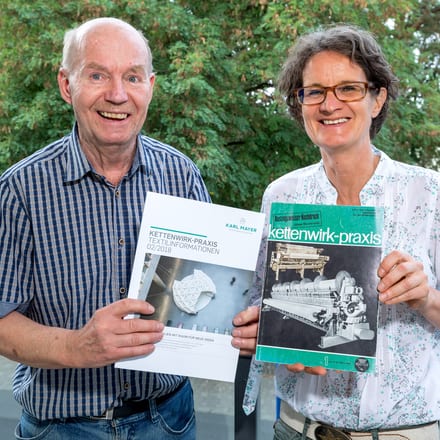“Kettenwirk-Praxis” is celebrating its 50th anniversary
50 years, two editors
The first regular edition of “Kettenwirk-Praxis” appeared at the beginning of 1968. Then, as now, this specialist textile magazine was published by KARL MAYER Textilmaschinenfabrik GmbH. Editing, printing and dispatch were all done by the company’s own works union, Karl Mayer e.V. The first editor was Rolf Hufschläger.
The textile engineer, Rolf Hufschläger, had clear objectives and a well-thought-out strategy. “The technical and educational magazine, 'Kettenwirk-Praxis', can offer everyone involved in the warp knitting industry - from those new to the sector to specialist technicians and engineers - the opportunity to gather technical information, as well as supplement and broaden their existing knowledge,” he said in the introduction to the first edition. The information was printed on perforated, detachable pages and the text was printed under different headings, which enabled the readers to create their own reference files. For example, the file system for practical use on the factory floor and workshop covered topics like tips, tricks, accessories, care and maintenance, machine technology and machine presentations. The teaching/education section included topics such as constructions/technical calculations and yarn information.
This arrangement continued until the end of 2001, when Ulrike Schlenker became the editor following the retirement of Rolf Hufschläger. This textile engineer replaced this type of file arrangement with market-oriented sections on Fashion, Technical Textiles, Home Textiles and Warp Preparation. These changes were partly triggered by the technical advancements that were being made. “The performance of warp knitting machines and warp preparation machines was increasing all the time, but they were also becoming more complex. Intervention was becoming less advisable, just as with cars,” says Ulrike Schlenker. On the other hand, the markets had also changed. Demand was being fully met, and textile manufacturers were looking for new sales markets and niches. Instead of needing tips and tricks for their day-to-day operations, they needed ideas and stimuli for new products and applications. Another reason for the changes that were made to the magazine was increased mobility through globalisation. People who wanted more information on the machines would travel to trade fairs all over the world.
As well as making changes to “Kettenwirk-Praxis”, Ulrike Schlenker kept some of the old favourites. For example the Patterns section still exists to this day and includes actual fabric samples, and the magazine is still published in several languages. The first English translation appeared in 1970. Initially, only a few selected texts were translated and included as inserts. Since 2002, separate versions with the same layouts have been produced in English and Chinese. The print run for the Chinese edition has increased considerably over the years, whereas there is less demand now for the German edition, which is a reflection of the markets.
Nonetheless, Ulrike Schlenker still relies on the help and advice of Rolf Hufschläger. Every quarter, once the latest edition has been published, she meets her predecessor for a debriefing. “The most important thing that Rolf Hufschläger has given me was the concept of: 'Right, let’s leave it at that!' The idea is that, 'Once an article is perfect, leave it well alone',” says Ulrike Schlenker when looking back on her early days as editor.
Ulrike Schlenker interviewed Rolf Hufschläger in German when they met recently to mark the 50th anniversary of KWP.
US: It is unusual for a machine manufacturer to publish its own technical magazine. How did this come about?
RH: In the sixties, most technologists in the knitting sector only really knew about weft knitting. Warp knitting was clearly under-represented. The founder of the company, Karl Mayer, wanted this to change and came to me with a plan to produce a technical leaflet. I immediately saw the potential that warp knitting could offer the technical sector. Instead of a leaflet, I suggested that we produce a technical journal. I had been thinking about this idea for a while. After the first few editions, the floodgates opened. I gathered more and more readers, e.g. by having a desk at the big textile machinery fairs, and built up the advertising business.
US: A huge undertaking, but how can the editor of such a specialist technical journal remain independent?
RH: As the editor of a specialist magazine published by a private company, I put a great deal of emphasis on impartiality right from the beginning. Over the years, I had gained the reputation of being neutral and independent. Keeping an eye on things, a feel for the technology, and real passion were also important. There was no blueprint to follow. From the narrow field of warp knitting, I had to filter out what was of interest, e.g. by attending conferences and trade fairs or by interviewing people on interesting topics. I had to seize the opportunity immediately and stick with it. I did everything on my own. This gave me a huge insight into what was going on and was very exciting. There was always something new happening and, as the editor, I was involved in everything.
US: What have been your biggest editorial achievements?
RH: I received the best feedback from the “Compendium” sections, but they also made the most work for me. These review articles included several articles on the same topic, for example, on lace or denim. In one of the Compendia, I described all the fibres that can be processed on warp knitting machines – a huge amount of work, but also a “great story” as Hans-Joachim Koslowski pointed out. At that time, he was the editor-in-chief of the man-made fibre and textile technology journals published by the Deutscher Fachverlag in Frankfurt, and he helped me by providing information.
US: At the end of 2001, you passed the baton on to me. What were the considerations behind this change of editor? What changes were needed?
RH: In the run-up to the changeover, we discussed whether we should stop publishing in print and publish the articles on the Internet. The World Wide Web was just beginning to take off. Even back in the 1990s, Karl Mayer had looked at this issue and came up with a clear answer: “People must have something to hold in their hands.” We did think about it. The Patterns section, with its original fabric samples, also favoured a printed journal format. Now, things are different. I am excited to see what direction “Kettenwirk-Praxis” will take.
US: In the future, there is no doubt that we will also apply the advantages of digitisation to our technical journal, but we will also keep the tried-and-tested favourites. Herr Hufschläger, thank you for this interview.
Back to overview
